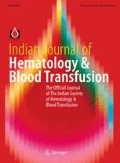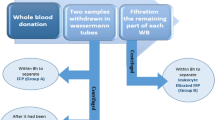Abstract
Thawed plasma is fresh frozen plasma (FFP) that has been stored for 5 days at 1–6 °C. Duration of storage and different storage temperatures might affect the coagulation factor activity in thawed FFP. This study measured the changes of coagulation factor activities over 5 days in thawed FFP and stored at two different initial storage temperatures. Thirty-six units of FFP, which consisted of nine units each from blood groups A, B, AB, and O, were thawed at 37 °C. Each unit was divided into two separate groups (Group A and Group B) based on initial storage temperature. The first group was stored at 2–6 °C for 5 days (Group A). The second group was stored at 20–24 °C for initial 6 h followed by 2–6 °C for 5 days (Group B). Prothrombin time (PT), activated partial thromboplastin time (APTT), coagulation factor activities of fibrinogen, factor (F) II, FV, FVII, FVIII, FIX, FX, and von Willebrand factor antigen (vWF Ag) were assessed at baseline after thawing, at 6 h, and on days 1, 3, and 5 of storage for both groups. All coagulation factors mean activities in both storage groups decreased significantly over 5 days of storage. The mean FVIII activity at day 5 of storage was 36.9% in Group A and 39.8% in Group B. The other coagulation factors mean activities were > 50% on day 5 of storage in both groups. The coagulation factor activities of thawed FFP stored for 5 consecutive days were reduced in the two storage groups but most of the activities were still above 30%. This study suggests that thawed FFP stored for 5 days has the potential to ameliorate coagulation factor deficiencies in affected patients.




Similar content being viewed by others
References
Stanworth SJ, Grant-Casey J, Lowe D, Laffan M, New H, Murphy MF et al (2011) The use of fresh-frozen plasma in England: high levels of inappropriate use in adults and children. Transfusion 51(1):62–70
Kakaiya R, Aronson C J J. (2011) Technical Manual AABB. In: Roback J, Grossman B, Harris T, Hillyer C, 17th edn. American Association of Blood Banks p. 187–226
Yazer MH (2012) A primer on evidence-based plasma therapy. ISBT Sci Ser 7(1):220–225
Downes KA, Wilson E, Yomtovian R, Sarode R (2001) Serial measurement of clotting factors in thawed plasma stored for 5 days. Transfusion 41(4):570
Eder AF, Sebok MA (2007) Plasma components: FFP, FP24, and thawed plasma. Immunohematology 23(4):150–157
Australian and New Zealand Society of Blood Transfusion (2013) Extended life plasma: A framework for preparation, storage and use, 2nd edn. Australian and New Zealand Society of Blood Transfusion Ltd, Sydney
Scott E, Puca K, Heraly J, Gottschall J, Friedman K (2009) Evaluation and comparison of coagulation factor activity in fresh-frozen plasma and 24-hour plasma at thaw and after 120 hours of 1 to 6 °C storage. Transfusion 49(8):1584–1591
Wang Z, Du X, Li C, Ma L, Sun P, Cao H et al (2014) Coagulation factors and inhibitors in thawed plasma stored at 1–6 °C for 5 days in China. Transfus Apher Sci 50(2):274–280
National Blood Centre (2016) Ministry of Health Malaysia. Transfusion Practice Guidelines for Clinical and Laboratory Personnel. 4th ed
Nascimento B, Callum J, Rubenfeld G, Neto JBR, Lin Y, Rizoli S (2010) Clinical review: Fresh frozen plasma in massive bleedings–more questions than answers. Crit Care 14(1):202
Wehrli G, Taylor NE, Haines AL, Brady TW, Mintz PD (2009) Instituting a thawed plasma procedure: it just makes sense and saves cents. Transfusion 49(12):2625–2630
Radwan ZA, Bai Y, Matijevic N, del Junco DJ, McCarthy JJ, Wade CE et al (2013) An emergency department thawed plasma protocol for severely injured patients. JAMA Surg 148(2):170–175
Holcomb JB, Donathan DP, Cotton BA, Del Junco DJ, Brown G, Wenckstern TV et al (2015) Prehospital Transfusion of Plasma and Red Blood Cells in Trauma Patients. Prehosp Emerg Care 19(1):1–9
von Heymann C, Keller MK, Spies C, Schuster M, Meinck K, Sander M et al (2009) Activity of clotting factors in fresh-frozen plasma during storage at 4 °C over 6 days. Transfusion 49(5):913–920
Feng L, Zhao Y, Zhao H, Shao Z (2014) Effects of storage time and temperature on coagulation tests and factors in fresh plasma. Sci Rep 4:3868
Tholpady A, Monson J, Radovancevic R, Klein K, Bracey A (2013) Analysis of prolonged storage on coagulation Factor (F)V, FVII, and FVIII in thawed plasma: is it time to extend the expiration date beyond 5 days? Transfusion 53(3):645–650
Sheffield WP, Bhakta V, Mastronardi C, Ramirez-Arcos S, Howe D, Jenkins C (2012) Changes in coagulation factor activity and content of di(2-ethylhexyl)phthalate in frozen plasma units during refrigerated storage for up to 5 days after thawing. Transfusion 52(3):493–502
Milam JD, Buzzurro CJ, Austin SF, Stansberry SW (1980) Stability of factors V and VIII in thawed fresh frozen plasma units. Transfusion 20(5):546–548
Sidhu RS, Le T, Brimhall B, Thompson H (2006) Study of coagulation factor activities in apheresed thawed fresh frozen plasma at 1–6 °C for 5 days. J Clin Apher 21(4):224–226
Naghadeh HT, Maghsudloo M, Tabatabaei MR (2011) Coagulation factors V, VIII, and X, prothrombin time and activated partial thromboplastin time test results in thawed plasma stored at 1–6 masculine C for 5 days. Blood Transfusion 9(1):95–98
Pipe SW, Morris JA, Shah J, Kaufman RJ (1998) Differential interaction of coagulation factor VIII and factor V with protein chaperones calnexin and calreticulin. J Biol Chem 273(14):8537–8544
Franchini M, Capra F, Targher G, Montagnana M, Lippi G (2007) Relationship between ABO blood group and von Willebrand factor levels: from biology to clinical implications. Thrombosis J 5:14
Yazer MH, Cortese-Hassett A, Triulzi DJ (2008) Coagulation factor levels in plasma frozen within 24 hours of phlebotomy over 5 days of storage at 1–6 °C. Transfusion. 48(12):2525–2530
Lamboo M, Poland DC, Eikenboom JC, Harvey MS, Groot E, Brand A et al (2007) Coagulation parameters of thawed fresh-frozen plasma during storage at different temperatures. Transfus Med 17(3):182–186
Engbers MJ, Cushman M, Rosendaal FR, Van Hylckama Vlieg A (2012) The effect of time between venipuncture, processing and freezing on the measurement of coagulation factor levels. J Thromb Haemost 10(8):1691–1693
Dzik WH, Riibner MA, Linehan SK (1989) Refreezing previously thawed fresh-frozen plasma. Stability of coagulation factors V and VIII:C. Transfusion 29(7):600–604
Ben-Tal O, Zwang E, Eichel R, Badalbev T, Hareuveni M (2003) Vitamin K-dependent coagulation factors and fibrinogen levels in FFP remain stable upon repeated freezing and thawing. Transfusion 43(7):873–877
Aggeler PM (1961) Physiological basis for transfusion therapy in hemorrhagic disorders: a critical review. Transfusion 1(2):71–86
Acknowledgements
The study is funded by AMDI Student Incentive. This work was performed at the National Blood Centre, Malaysia. The authors thank the staff of the Haemostasis and Thrombosis Unit of the National Blood Centre for assisting with coagulation assays and the staff of the Advanced Medical and Dental Institute, Universiti Sains Malaysia.
Author information
Authors and Affiliations
Corresponding author
Ethics declarations
Ethical approval
All procedures performed in studies involving human participants were in accordance with the ethical standards of the institutional and/or national research committee and with the 1964 Helsinki declaration and its later amendments or comparable ethical standards.
Rights and permissions
About this article
Cite this article
Noordin, S.S., Karim, F.A., Mohammad, W.M.Z.b.W. et al. Coagulation Factor Activities Changes Over 5 Days in Thawed Fresh Frozen Plasma Stored at Different Initial Storage Temperatures. Indian J Hematol Blood Transfus 34, 510–516 (2018). https://doi.org/10.1007/s12288-017-0879-8
Received:
Accepted:
Published:
Issue Date:
DOI: https://doi.org/10.1007/s12288-017-0879-8




